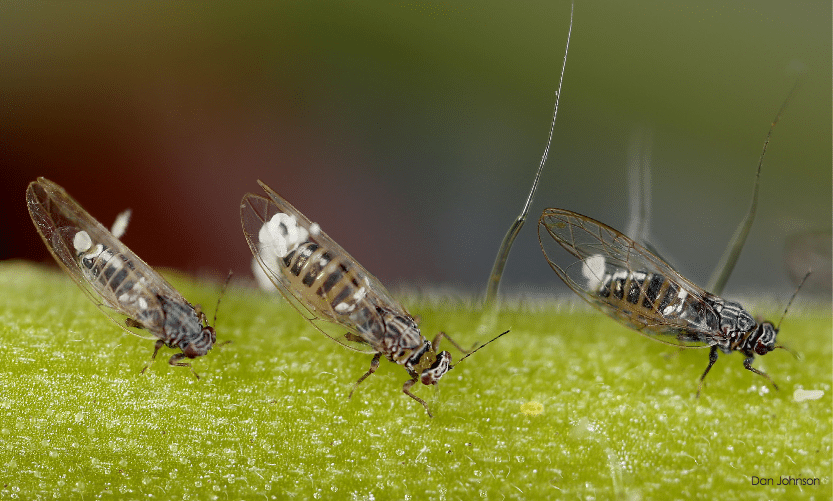[deck] No evidence found of bacteria that causes zebra chip disease[/deck]
University of Lethbridge biogeography professor Dr. Dan Johnson and his team have been monitoring Prairie potato fields for the past few years, looking for evidence of the potato psyllid insect and a bacterium it can carry that can lead to zebra chip disease in potato crops.
So far in 2017, the number of potato psyllids has been lower than in previous years. U.S. researchers and research news also report lower numbers this year, says Johnson.
“In Alberta in 2017, in 40 potato fields (160 stakes with cards, with grower permission) for which we know the location and conditions, examination every week (or sometimes two weeks) yielded only two potato psyllids in June and 10 potato psyllids by late July,” he says.
“In early August, potato psyllids seem to have completed a life cycle and produced a small increase, as seen in data collected Aug 9-10, with potato psyllids found on cards increasing to a total 45 in our 40 fields, plus additional cases outside of fields. This total number is still lower than last year, but illustrates the need to continue sampling in August and September.

“We know that potato psyllids do overwinter in Canada, but so far, none of the potato psyllids or potato plant samples tested in the Larry Kawchuk lab at the Lethbridge Research Centre have the Lso zebra chip pathogen.”
Johnson says that in 2017, populations of the natural enemies of aphids, thrips and psyllids in potato fields are lower than in previous years, across most of the sampled fields, but he isn’t sure why that is the case.
“I think the main message is the numbers increased quite a bit around Aug. 1, as they should, but nobody in Canada needs to take action like spraying,” notes Johnson. And, so far the zebra chip pathogen has never been detected in Canada, although we are looking.”
The objective of the project — Zebra Chip and Potato Psyllid Survey and Monitoring — and network — Canadian Potato Psyllid and Zebra Chip Monitoring Network — is to survey fields for populations of the potato psyllid in Canada, and test captured potato psyllids and symptomatic tubers for the presence of the disease agent, Lso. The network of researchers and collaborators participates in conducting field sampling, identifying species and stages, mapping occurrence if found, developing and implementing a monitoring program, assessing the effects of weather and regional variations and movements, determining potential geographic range, constructing a geographic forecasting model of the insect life history and development, and developing a management plan.
The monitoring project is funded by Growing Forward 2, the Canadian Horticultural Council and Potato Growers of Alberta. The folks working on the project include Johnson, Larry Kawchuk with Agriculture and Agri-Food Canada at Lethbridge (AAFC), Scott Meers, with Alberta Agriculture and Forestry (AAF), and various network participants. DNA testing for the bacteria is done in the Larry Kawchuk lab at the Lethbridge Research Centre, where Johnson is also a visiting scientist.
Zebra chip has affected potato crops in the United States, Mexico and New Zealand, causing millions of dollars in losses. Potatoes with zebra chip develop unsightly dark lines when fried, making affected potatoes unsellable. Given Alberta’s potato industry is worth more than a billion dollars alone, scientists and field workers want to ensure the province’s and Canada’s potato fields are being monitored.
At the end of last summer, Johnson found potato psyllids in Saskatchewan and Manitoba, thanks to cards collected and sent by network members there. Slightly sticky cards are placed on stakes in the fields and later examined under microscopes. With the expansion of the Canadian monitoring network, the researchers can map locations where the psyllids are found and compare their numbers to weather patterns and natural enemies of the pests.
Johnson and his team have produced a newsletter with a colour photo guide so growers can more easily identify the stages of the potato psyllid.
The Canadian monitoring program began in 2013 in cooperation Scott Meers, an insect management specialist with AAF. No psyllids were found in 2013 or 2014, and small numbers were detected in 2015 and 2016. That none have carried the bacteria that leads to zebra chip is good news.











